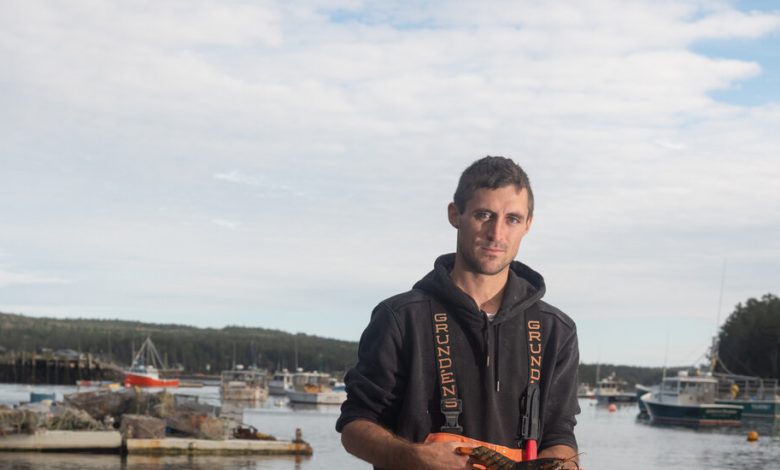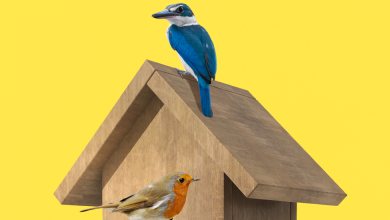TikTok’s Finest Lobsterman

It was another busy day for the crew of the Rest-Ashoar, a lobster fishing boat that works the waters off the rocky coast of Winter Harbor, Maine. The captain, Jacob Knowles, had gotten up at 3 a.m. on a brisk October morning and took his vessel 10 miles into the ocean.
Using a hydraulic hauler, buoys and ropes, Mr. Knowles, Keith Potter (the stern man) and Coty White (the third man) hauled up 400 wire traps over the next 10 hours. They pulled legal-size lobsters — at least 3.25 inches but not over 5 inches, from its eye to the back of its shell — from each baited cage and tossed back the smaller ones. As the boat listed in the rolling waves, they heaved the empty traps back overboard.
Even while doing the grueling work of commercial fishermen, the crew was engaged in another job: filming a video.
Over the past two years, Mr. Knowles, 30, has amassed a large audience on social media by sharing snippets of his workday with his 2.5 million followers on TikTok and nearly 400,000 followers on Instagram. Wearing an orange Grundens rubber fishing bib and a matching coat, he stands on the deck and, in a Down East accent, gives tutorials about, say, lobster reproductivity, or how to remove barnacles from the shells of crabs.
In September, the Rest-Ashoar added a fourth crew member: Griffin Buckwalter, 20, a videographer. On fishing trips, he often sits in the cabin, editing footage on a laptop.
Mr. Knowles is one of several people in what are considered blue-collar jobs who use social media to offer a window into their lives. Their videos are about as far as you can get from the “get ready with me” makeup videos that are a TikTok staple, resembling instead a social media version of “Dirty Jobs,” the long-running show on the Discovery Channel. In some cases, as with Mr. Knowles, these hard-working influencers have signed sponsorship deals with brands, giving them an additional source of income.
Another popular online figure who works outdoors is Adam Perry, a tree trimmer in England, who has racked up 245,000 followers on Instagram by posting videos of himself scaling trees with a chain saw and tying knots with names like double Portuguese bowline and clove hitch. There is also Hannah Jackson, who herds sheep in the rolling hills of Cumbria, England, and goes by theredshepherdess on TikTok, where she has 100,000 followers. A recent post introduced her new herding dog, Mick.
Ms. Jackson, 31, said her feed appeals to “people who are in a little more of a townie setting.” “Probably because I explain farming in a really easy way,” she said. “People feel quite comfortable that they can ask questions and not feel stupid.”
With her red hair and cheeky humor, Ms. Jackson is a striking presence, and she has parlayed her online success into a memoir that was a best seller in England. She has also appeared on the BBC show “Countryfile” and signed sponsorship deals with Can-Am, which makes off-road vehicles, and other companies.
“It really helps support the farm,” she said of the money she earns through posting.
The audience for these creators includes people who do their jobs from their desks. Michael Williams, who runs A Continuous Lean, the men’s style site turned newsletter, said he follows the social media accounts of a mechanic, an electrician and a long-haul truck driver.
He said he especially liked the posts of Robert Allen, a pilot with nearly 400,000 TikTok followers whose videos spotlight a niche of the aviation industry. Mr. Allen, known online as CaptainBob, is a founder of Nomadic Aviation, a company that ferries planes around the world when they are sold, brought in for maintenance or converted from commercial airliners into cargo jets.
“He’s in all these weird places in the world, doing a cargo conversion,” Mr. Williams said. “If you’re into that sort of thing, it’s very compelling.”
The lobsterman, the shepherd and the pilot have little in common with the young fashion and lifestyle creators who rose to prominence more than a decade ago. These earlier online influencers built their followings by showcasing their personal style or by offering beauty, decorating or parenting tips. The savviest among them turned online fame into cash through brand partnerships.
“When we think of influencers, we think of a blond woman wearing a two-piece outfit, holding a designer purse and posed on a hotel balcony,” said Alice Marwick, an associate professor at the University of North Carolina at Chapel Hill whose research focuses on social media.
That’s largely because Instagram was suited to promoting aspirational lifestyle content when it arrived as a photo sharing app in 2010. “It has an aesthetic quality that lends itself to beauty, lifestyle, travel, food — these very curated, highly visual areas,” Professor Marwick said.
A parallel strain of social media fame centered on male YouTubers like Jake Paul and MrBeast, who relied on spectacle, quick-cut editing and bluster to build large followings, especially among young men.
When TikTok took off, its short-form videos were rawer, more unfiltered, and people could go viral just because they were able to say interesting things to the smartphone camera or had an unusual lifestyle. “That’s where we’re getting these blue-collar influencers,” Professor Marwick said. “We know these jobs exist, but we don’t really know what it’s like behind the scenes.”
Ms. Jackson said that, while growing up, she didn’t know farming was something you could do for a living without being born into it, and she had no female role models. She frequently hears from women from all walks of life who thank her for showing her day-to-day life. “It’s women in general being a bit more brave and trying things society thinks they shouldn’t,” Ms. Jackson said.
Authenticity seems to be another draw. The blue-collar creators don’t live in content houses in Los Angeles, their feeds aren’t (yet) cluttered with sponsored posts, and they don’t appear to be using social media as a springboard to internet fame, given that they have dedicated years to working a trade.
Mr. Allen’s videos often feature a package of peanut M&Ms somewhere in the pilot’s cabin. He calls the candy his good luck charm and makes sure he stocks up before embarking on any international flights. Reached by video call in London, Mr. Allen, 57, laughed at the suggestion that he was being paid by Mars, the candy’s maker.
“M&M’s should be paying me,” he said, adding, “I think they’re unaware.”
His route to TikTok fame was unlikely. He was an investor in a company that makes bug repellents, including a bedbug killer that debuted around the time the pandemic hit and hotels closed. To help sell the product, he said, he studied up on social media marketing and joined TikTok.
“Nobody cared about these bedbug products, but they were asking me, ‘Where are you flying?’ ‘What do you do?’ ‘Show more of the airplane,’” Mr. Allen recalled. “There are a lot of people interested in aviation, apparently. I really had no idea.”
Many of his followers, he said, are people who, for various reasons, are unable to hop on a plane and see the world. And they see him as a regular guy. “I’m eating terrible,” Mr. Allen said. “I’m not getting the proper rest. I’m getting my catering from convenience stores. There’s guys like truckers that can relate to that.”
Mr. Allen’s account has also become an inspiration for some young aviators — not least because pilots and crew members working for commercial airlines are barred by their employers from posting the sort of revealing content that he shares.
When he recently delivered a plane to Sanford, Fla., Mr. Allen was greeted like a celebrity by Drew Cripe, 21, a pilot working toward his airline transportation license.
“When you’re, like me, still trying to build hours to get to the airlines, you know about the pay, you know about the daily flying of Point A to Point B, but you never get to see the behind the scenes,” Mr. Cripe said. “Bob is well known around my flight school because he provides such an insight into that airliner world.”
It helps that the Kentucky-born Mr. Allen is a natural on camera, with a smooth drawl and a love for aviation that comes through in his videos.
Joe Seppi, the long-haul trucker Mr. Williams follows, has found social media fame, has a curmudgeonly personality and dry humor that bonds him with his fans. Standing beside his rig along a busy freeway, the big-bearded, ball-cap-wearing Mr. Seppi will grumble about having to drive an automatic instead of manual transmission or some other workplace issue, then parry with followers who leave comments.
Despite his job and remote location, Mr. Knowles, whose family has been in the lobster business for generations, is something of an online veteran. He said he started posting videos to YouTube about his hunting and fishing adventures in northern Maine as a teenager. Three months ago, he signed with Greenlight Group, a talent management company.
“We monitor creators who are homespun and blue-collar, like Jacob,” said Doug Landers, a founder of the agency. The firm also represents Gabriel Feitosa, a dog groomer with 2.3 million TikTok followers, and Jordan Howlett (known as Jordan the Stallion), who has amassed 11 million followers on TikTok with videos about the fast-food restaurants where he once worked.
Mr. Landers said that he has been brokering brand partnerships for Mr. Knowles and helping him expand his “narrative bubble” beyond the deck of the Rest-Ashoar.

Mr. Knowles recently added a videographer to his crew and pays him with what he earns through sponsorships.Credit…Kate Greene for The New York Times
Sitting in the cluttered gang room of the Winter Harbor Coop, the office shack for fishermen, Mr. Knowles was wearing a black heavyweight hoodie by American Giant — his first significant brand partnership. He has also recently signed deals with BetterHelp, a mental health platform; CapCut, a maker of graphic design tools; and AG1, a nutritional supplement.
He recalled how he stumbled into viral fame in 2020 after posting a TikTok video explaining the meaning of “egger” — an egg-laden female lobster that, when caught by a fisherman, is given a V-notch in its tale in an effort toward keeping fisheries sustainable.
“After she has a V-notch, she’s illegal to keep for the rest of her life,” Mr. Knowles said. “When I posted that one, it went mega-viral.”
He and his wife have three young children, so he has welcomed the money from sponsorship deals, he said. Besides, his TikTok sideline makes the monotony of long days on the water pass more quickly. “We’re out there for 10 hours with nothing to do except talk,” he said.
These days, the captain and his crew dream up ideas for TikTok. Their videos have become more goofy and semi-scripted as their following has grown. When Mr. White joined the boat as the third man, he attempted to roll on a log drifting in the frigid ocean for his initiation video.
Indeed, Mr. Knowles seems on the precipice of something few, if any, lobstermen have ever faced. If more brand deals come about, and if his following continues to grow, he may soon earn more for his posts than for his catches. He would become a kind of actor, then, playing the role of a rugged Maine lobsterman. And that would be fine by him.
“It’s hard on your body, hard on your back,” Mr. Knowles said of lobstering. “I love it, and I probably will always do it, but I’d like to get to the point where I’m doing it for fun. Not so I have to wake up at 3 a.m. and go do it.”



